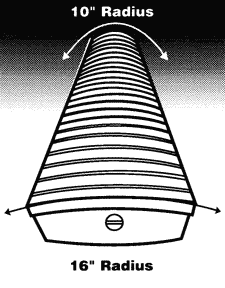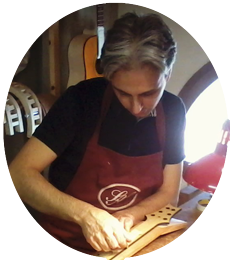
Visit the new website: www.buildyourownguitaronline.com
HOME > Compound radius fretboard
COMPOUND RADIUS FRETBOARD
Conceived by the Warmoth brothers, the compound fretboard starts from the nut with a radius of 10 inches (the same as with most common Floyd fretboards) and then gradually flattens to 16 inches at the 22nd (or 24th) fret.
This unique feature gives the musician a comfortable radius in the first positions where rhythms and arpeggios are performed, a medium radius in the middle positions for two-handed techniques, and a very flat radius in the high register for a very low action and bending capable of two and a half tones bending without buzzing.

Compound radius vs constant radius
Due to its geometrical structure (I'll spare the complicated math formula), compound radius is the only one to make the strings mirror the same neck relief, thus allowing perfect neck adjustment.
This does not happen on constant radius fretboards, where the width of the fretboard changes along its length, but the radius under it remains
the same. Indeed, if we adjust a constant radiused fretboard for a perfect relief (light up-bow) using the outer strings as a reference (high E),
this will cause the inner strings (A and D) to mirror a straighter fretboard.
Due to its geometrical structure (I'll spare the complicated math formula), compound radius is the only one to make the strings mirror the same neck relief, thus allowing perfect neck adjustment.
This does not happen on constant radius fretboards, where the width of the fretboard changes along its length, but the radius under it remains
the same. Indeed, if we adjust a constant radiused fretboard for a perfect relief (light up-bow) using the outer strings as a reference (high E),
this will cause the inner strings (A and D) to mirror a straighter fretboard.


